Monday 15 August – Sylvia
We had an extremely early start with a 5am pick up from the hotel this morning. All went fairly smoothly with our flights from Rio to Brasilia and on to Cuiaba, where we were met by our guide for the next few days, Lucy.
Cuiaba is a small dusty city of roughly 600 thousand people out in the middle of Brazil. We headed out of town on the main highway that runs from Sao Paulo in Brazil all the way to Lima in Peru. After some time we turned off, heading to Pocone, the gateway to the Pantanal, where we stopped for a Brazilian style buffet lunch – think a very rough version of a Brazilian Churasco restaurant. The signs depicting male and female toilets were fairly self-explanatory.
We then left the sealed road behind and started the roughly three hour drive on the Trans-Pantaneira Highway to South Wild Pantanal Lodge where we will stay for the night. This area is a large flood plain and many of the bridges are being repaired and/or rebuilt but the road is generally in good condition. It is fairly flat and scrubby, punctuated with the occasional bright yellow or pink tree. We also pass several large, well-kept farms. Despite the traffic being fairly sparse, it is enough to paint the foliage up to 5m on either side of the road with a thick coat of fine, dull, brown dust.
We stopped often to look at a wide variety of birds as well as green iguana, capybara, pampas deer, marsh deer and South American coati. An over-abundance of caiman wallowed within striking distance of several very game birds, occasionally creating a bit of a ruckus. The large jabiru stork is impressive as is the rhea but I think our favourite birds were the roseate spoonbills, the female a dusky pink and the male pink with scarlet on his wings.
At the lodge there are young jabiru storks in a nest right nearby. We also saw toco toucans in a tree right outside our door and capybara grazing on the lawn.
After a few brief moments to unpack we headed off for a walk and then a wait in a hide, hoping to see ocelot. We spotted a couple of howler monkeys high in a nearby tree and several more birds but unfortunately the ocelot didn’t show today.
Tuesday 16 August
We hit the road on the back of a truck with seats for game watching for our three-plus hour journey to the Cuiaba River. We stopped numerous times to look at wildlife. At this time of year, with the hot season approaching, waterways are drying up so the game congregate in the pools that are left. Caiman congregated in their hundreds in some pools sharing the water with birds and fish.
The road was dirt with rickety wooden bridges in various stares of repair.
We stopped at one point to look at a bird and heard loud screaming. Looking through the scrub into a pool Giant Otters were making this noise.
A pair ok Hyacinth Macaws were kissing in a tree.
Just up the road a very rare tayra shot across the road.
Later a neotropical river otter crossed the road.
We saw many different birds.
Arriving at Port Jofre, we boarded a small boat with Lucy, our guide, and Juninio, the boatman. Thirty minutes up the river we arrived at the Jaguar Suites, our floating lodge for the next few days.
After lunch and a short rest we again boarded our small boat heading up river. Caiman lined the river bank and floated along mid-river with just their eyes and head protruding; as the boat got really close they slipped quietly away.
We rounded corner to see three boats stopped and all cameras aimed toward the right bank. Geoff, a 10 year old Jaguar, had been spotted. As we watched he hunted the river bank. (All jaguars’ spots are different and in order to track and monitor the jaguar are named – roughly 150 individuals have been identified in this area over the last 10+ years).
More boats arrived, one with a big camera and another with seats and camera mounts for the long lenses.
Soon there were seventeen boats waiting for Geoff to make a kill as he hunted the shoreline. There were several attempts where we heard a loud splash and thrashing around in the long river grass. Each time the caiman or capybaras escaped. At one point Geoff stood poised on the rivers edge for sometime, then bounded across the shallows onto a caiman. When the water subsided the caiman was gone
We left the other boats to it and cruised on around the maze of rivers. We passed hundreds of caiman and the odd capybara at the water’s edge.
We then came across another boat with cameras pointed to the bank. On the bank lay Bianca, our second jaguar sighting today.
We moved on around the river through a side water full of caiman, then out to the main river channel.
Soon the driver spotted two more jaguar.The light was fading as we moved closer. The mother (we think) on the right moved off. The cub sat there and with the aid of the flash we got some good shots. The cub had a wound just above its back leg, we are told probably a Bot Fly infection.
As we headed back along the river a fiery red sun was setting
Back at the Lodge there was great excitement. After a study of our photos it was decided that we had spotted a never seen before jaguar. This apparently gives us naming rights.
Wednesday 17 August – Sylvia
The mornings start early here. We were off after breakfast for our first 4-hour boat jaunt by 7am. We spotted the hapless Geoff not far from camp, still trying unsuccessfully to hunt. He must be getting hungry by now. After trying on one river bank, he decided he might have more luck on the other side and proceeded to swim across the river right in front of us. Jaguars are clearly strong swimmers as despite the current and the onlookers he made it across in no time.
We headed on down the river passing all the usual suspects. We came across a very noisy Giant Otter. Growing up to 2m in length, they live in family groups and communicate a lot. This one had become separated from the rest of his small group and kept up a horrible squealing noise until he was reunited with them.
As we were heading back we came across a couple of Brown Capuchins in a tree. They are certainly cute although apparently also quite vicious.
Jeff was still hunting as we passed by on our way back for lunch, and still being watched by numerous boats. I really hope he catches something while we are all having our lunch break.
Heading back out on the water at 2pm we came across a much larger family of nine Giant Otters, fishing in the reeds along the side of the river. They make quite a sound crunching through the armoured catfish and are really fun to watch as they are very active and interactive with each other. They often pop their heads up to take a good look at us but seem totally unperturbed by our presence.
Our route this afternoon took us down several smaller, narrower waterways. Several times we hit the bottom as the water got shallower eventually having to turn around and back-track. Caiman continue to be a ubiquitous presence and we saw several large families of Cabybara including a large group swimming.
I can only guess the Jeff was successful in his hunting and was happily chowing down as there was no sign of him, or any other jaguar, this afternoon.
After some discussion today Roger and I finally agreed on names for the previously unnamed jaguar we found yesterday. There are quite a few rules – simple names that the guides can say, need to reference gender (so need to provide both a male and female name until gender can be determined) etc. Given that this trip started out as an add-on to watching Kirstie at the Olympics we felt it only fitting that if the cub is a female it should be called Kirstie, however the local boatmen had difficulty with that so we landed on Beka. And if it is a male we have decided to call it Roger – he is not quite sure how he feels about the idea of having “a large pussy named after him”!
Thursday 18 August
Bang on 7am Lucy, our guide, Juninio, our driver, and Suzanne, who is the resident biologist, were waiting in the boat.
The South Wild Jaguar Suites floating lodge is situated just up the Piquiri River. We headed down to the junction of the Cuiaba River turning right up stream. First stop was to take a look at Mick Jaguar sitting on the river bank. With a bunch of observer boats looking on he soon wandered into the jungle, I presume looking for Jerry Jaguar.
A few hundred meters up river, Geoff the Jaguar was strutting his stuff up the river bank. After a brief stop we carried on up the river taking in the scenery. There are lots or red flowered trees in which fire ants live symbiotically.
We passed some skimmer birds with chicks, which they rapidly tried to hide in the sand as we approached.
We cut down a small channel until we bottomed out before heading back. Mid-morning we hit caiman alley, as we have started to call it.
We spotted a green iguana on the bank. With its long tail and bright colours it stood out.
It was here I had the chance to have a close encounter with a caiman. The driver had brought the boat up to the bank so I could photograph the iguana. The boat drifted along a bit and a caiman laying on the bank edge just stayed put, apart from giving a hiss when we were less than a meter away he stayed put. They reckon there are about ten million of these in the Pantantal; the population has recovered since the banning of all hunting of any game in Brazil in 1967. Prior to that a million or so a year went into hand bags and shoes.
With this guy being so close I was able to see him/her clearly. Apparently you have to stick your fingers in its slits to find its sex organ and define the sex – we decided he/she may not like that. The teeth are designed just to catch from front or side, food is not really chewed but swallowed whole or in large chunks. It was good to to see the thick scales on body and feet close up.
Unlike a crocodile these guys get up high on all four legs and walk rather than waddle.
Cruising back down the river we spotted a roadside hawk who looked on curiously as I took his pic.
Cocoi herons space themselves at almost regular intervals along the river bank as though keeping watch.
We arrive back at the lodge at 11am and head out again at 2pm. I asked if it were possible to go for a stroll in the jungle. “No chance” was the answer “too many Jaguars”. The swimming question was one I didn’t need to ask. Caiman don’t generally attack people but you might step on one, then there are piranha, not to mention the sharp teeth of the giant otter. The lodge and the boat are the only safe places to be.
We took a cruise up the Piquiri river. Apart from a bunch of vultures on the first corner and the odd capybara there wasn’t much doing.
We headed back down and up the Cuiaba. A few kms up there was a bunch of boats watching Jaguar Maxime who was asleep back in the bush. Eventually he got up and wandered off into the jungle. The boats spread out up and down the river. Eventually we were flat out down stream turning up into the Three Brothers River.
A couple of kms up the river the boats were congregating again. Maxime had walked cross-country a few hundred meters. We had traveled several kilometres by river to reach the same spot. These rivers really snake their way through the land. Maxime lay down behind some vines on the river bank for all to see.
As the boats rocked up we were amused by the variety of anchors. In actual fact we did not see one real anchor. The most common were engine crank shafts; the others all varied. There were many more.
Maxime gave a good yawn then got up and moved upstream a hundred or so meters. Anchors were raised the boats moved anchors dropped again.
There were two boats from the National Geographic on the scene, one with a remote controlled video camera mounted in such a way that as the boat rocked the camera stayed still. The camera man told us they had been on the river for two weeks and were staying until the end of September filming jaguar. Another boat had a big remote controlled camera on an arm counterbalanced with gym weights.
Maxime moved a couple more times before the light started to fade and it was time to head back to the lodge. When these last pictures were taken he was only 25 yards away, not at all bothered by all the onlookers.
Friday 19 August – Sylvia
The morning here started a bit overcast but otherwise pleasant. A leisurely boat ride this morning took us past giant otter, several families of capybara, caiman and plenty of bird life. At one stage we came across the flotilla of boats that indicate a jaguar is nearby but we had missed it as it had just disappeared back into the scrub.
We wound our way down a different river system and came out at a large property with a very well-kept homestead including several residences for the workers; apparently it belongs to some wealthy bigwig farmer from near here.
This afternoon we headed off up the Piquiri River and soon bumped into another family of giant otter. After watching them we continued on and came across a large troop of brown capuchins. They had been drinking at the river but rapidly scarpered up the trees as we neared.
We turned back, heading for the Cuiaba River and came across the most amazing sighting – a huge yellow anaconda was on a sand bar, heading slowly towards the water. A sunbittern was displaying and clicking its beak, clearly agitated by the snake’s presence. This seemed a bit like taking a pocket-knife to a gunfight. Sunbitterns are amazing birds and twitchers try for years to get photos of them displaying and here we were with one and an anaconda to boot (at least 2m long). Lucy has been guiding here for 4 years and this was only her second anaconda. Eventually the anaconda made it past the bird to the water and we thought it was all over but then the bittern headed up to a bush and continued clacking its beak. With the binoculars we could see a second anaconda in the bushes trying to make its way to the water, but the bird was too much for it and it retreated into the bush. In this case it seems the pocket-knife won!
We headed off up the Cuiaba River where a jaguar and two cubs had been spotted but again arrived too late. After meandering our way around a few smaller rivers, with plenty of caiman and different birds we headed back. Rounding a bend we saw all the boats lined up again and between them and us a jaguar swimming across the river. We only had a brief viewing as it disappeared into scrub again once it reached the other side but it was a fitting end to a fantastic afternoon.
Saturday 20 August
At seven am, bags packed and in the boat, we went for our final trip up river.
Caiman were mainly in the water with just eyes protruding and slipping beneath the surface as we approached. A bunch of otters played alongside the riverbank screaming at each other when one got separated.
Soon we headed down stream to Porto Jofre to meet the truck. There are is quite a bit of activity here with several house boats, hotels and even an air strip.
A few hundred meters down the road some people had spotted a Jaguar across the river. The boatman was called on the radio and picked us up at a little jetty. We raced across the river by which time the Jaguar was gone.
Back on the truck some hyacinth macaws did a fly past as if to send us off.
A tiger rat snake lay on the road, a caracara standing near by as though challenging the snake.
We drove 150km across the flats recrossing the rickety bridges, slowing and often waiting for the dust to settle as oncoming vehicles passed us.
It’s hard to believe that by February this scrubby hinterland will be submerged in water, most of the road impassable.
Some locals were netting small fish in a pool, apparently used as bait to catch larger fish.
We stopped to look at, and photograph more birds.
Three and a half hours later we arrived back at the South Wild Pantanal Lodge to be greeted by capybaras grazing on the lawn.
After lunch we took a slow stroll with Lucy alongside the river and into the forest. It was great to be able to stretch our legs after four days in and on a boat. We spotted a tegu lizard who did his best to hide in the undergrowth.
Lucy pointed out various insects and plants including a close look at some carrot-scented termites who had built their mound in a tree.
At around 5pm we settled into a hide. Lucy had gone back to the camp to get water leaving Sylvia and i waiting just in case an ocelot appeared. A few minutes we later saw the shape of an agouti through the scrub coming along the track. It stopped and froze just before the clearing, then took off in fright. A minute of so later the first ocelot appeared.
It was soon scared off by people coming along the track but later reappeared to be scared off again by Lucy and some other people coming to the hide.
Some raw chicken was put out and soon another ocelot appeared, had a feed and retreated to the scrub.
Now dark, a light was turned on and a third one appeared, not even deterred by the flash of cameras.
It is very rare for people to see these cats in the wild; South Wild has done a great job in habituating these elusive animals.

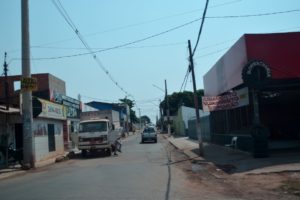


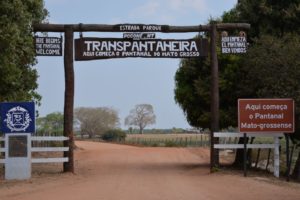


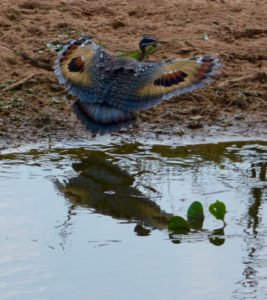
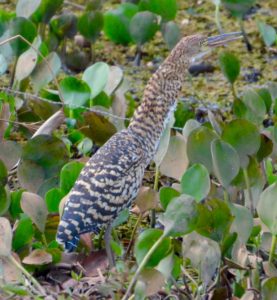
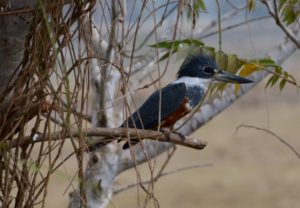

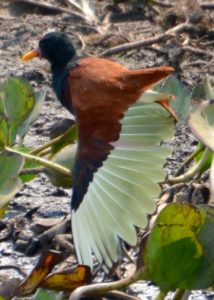


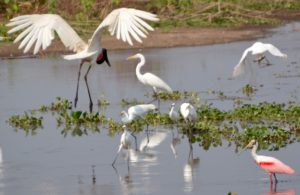




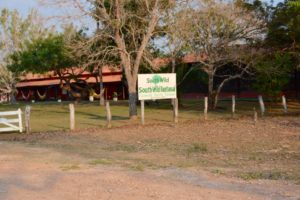
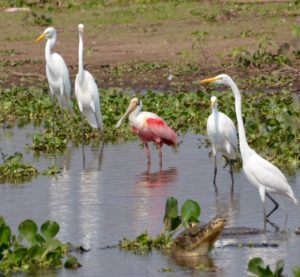





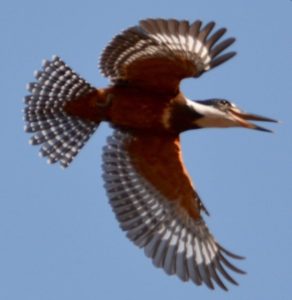




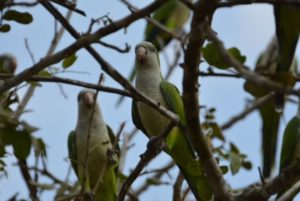


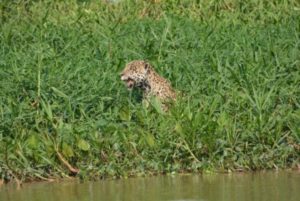





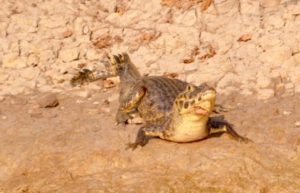

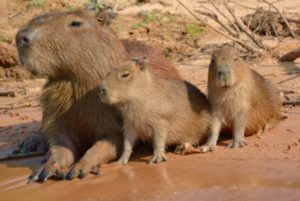

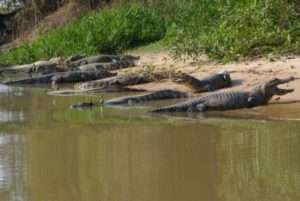

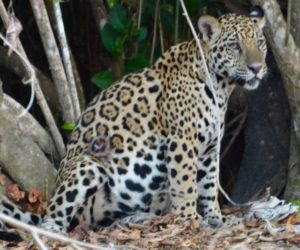






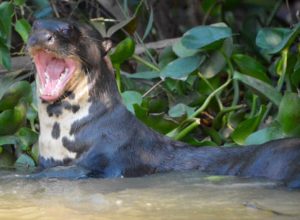

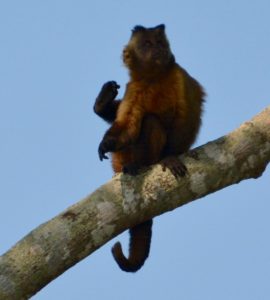

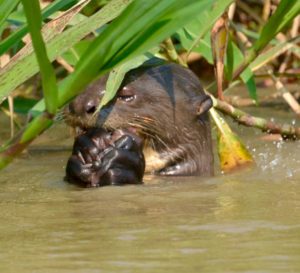







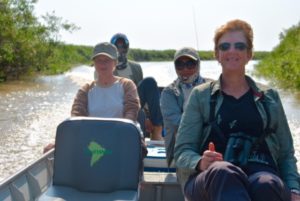


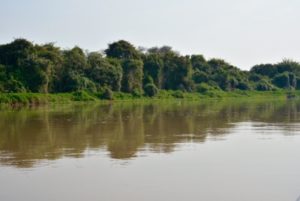









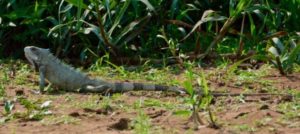
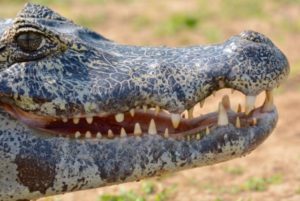

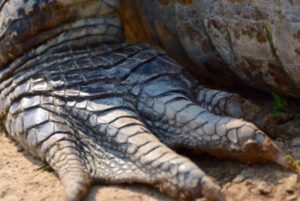


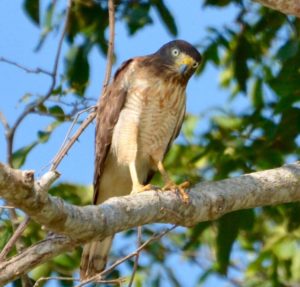
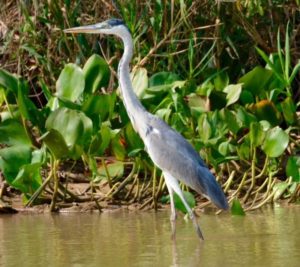
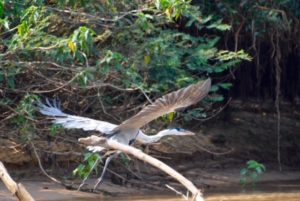




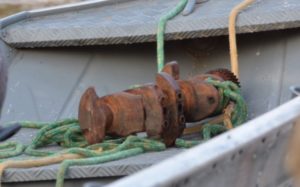


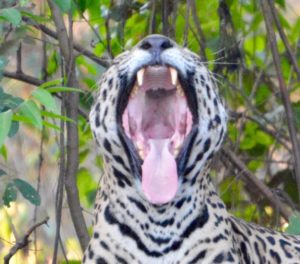









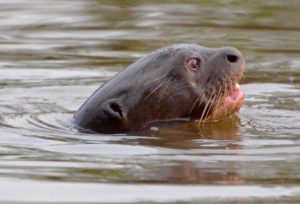

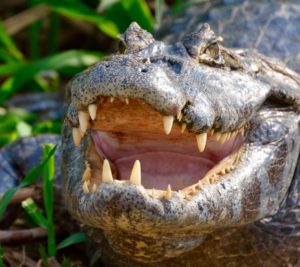
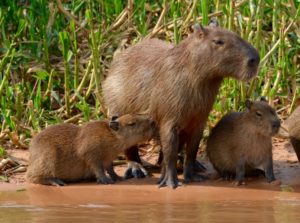


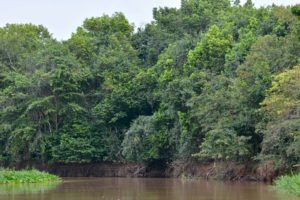
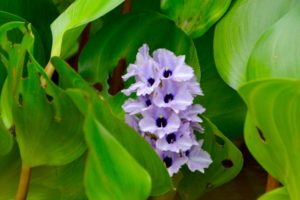


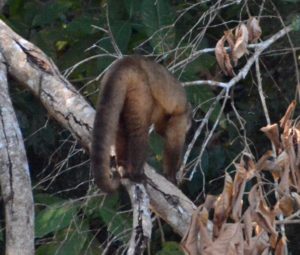

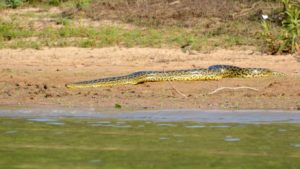
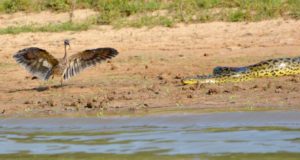

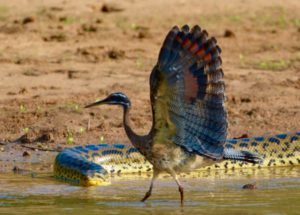
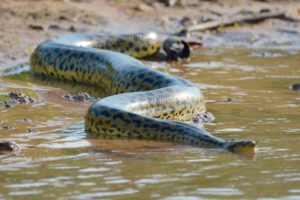
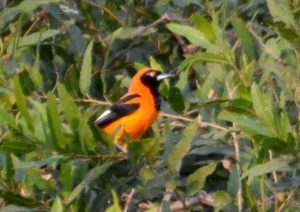
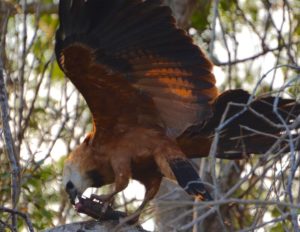

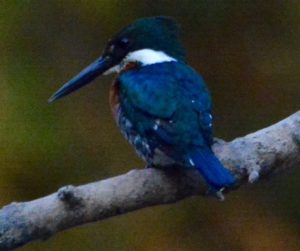





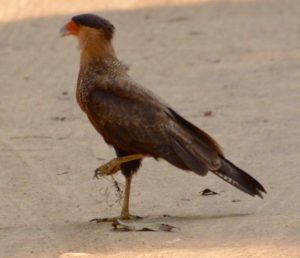
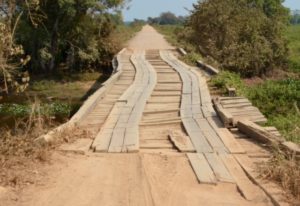
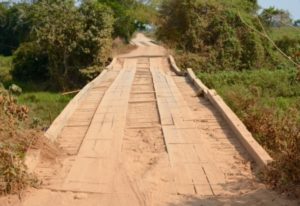
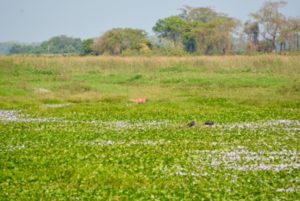
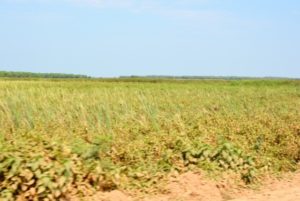


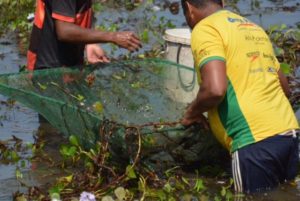








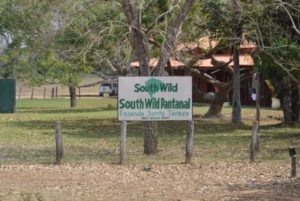

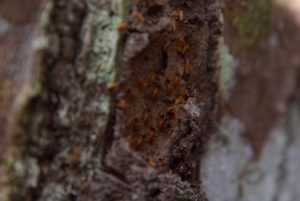




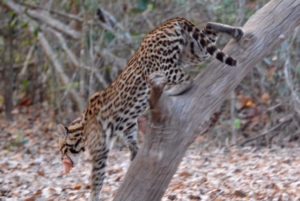
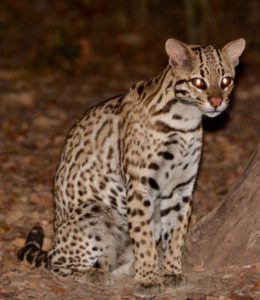

Hey Roger and Sylvia,
Just thought you would like to know, that pair of jaguars you saw up the Cuiaba, they were spotted again today, and we got a good picture of the mum.
She has been seen before, but not since 2013! So an excellent sighting. They also were able to tell that the cub was a male. So congratulations Roger on having a pussy named after you.
Suze
Great stories and photos Roger and Sylvia. Thanks for taking the time to share your experiences with us.
I’m picking you wont like a big pussy being named after you Roger lol. Best
AJ
Great pictures, thanks to come and visit the PANTANAL
Beautiful photos …
Wow … fantastic photos!! What an amazing experience. Love these stories – so interesting!!! Thanks for sharing.